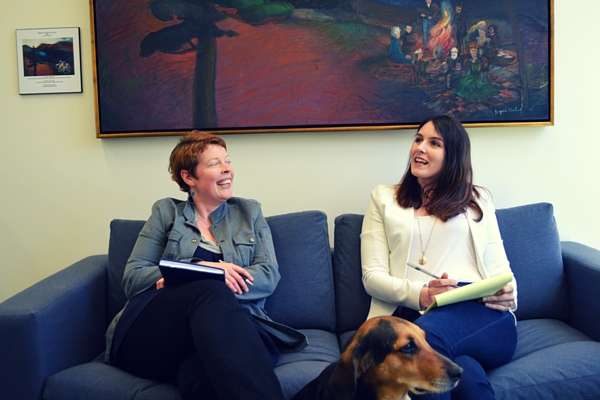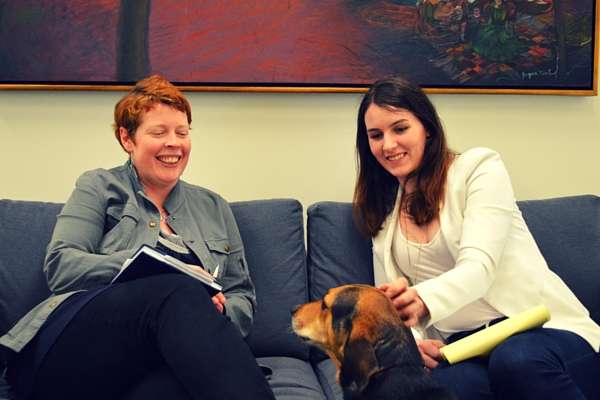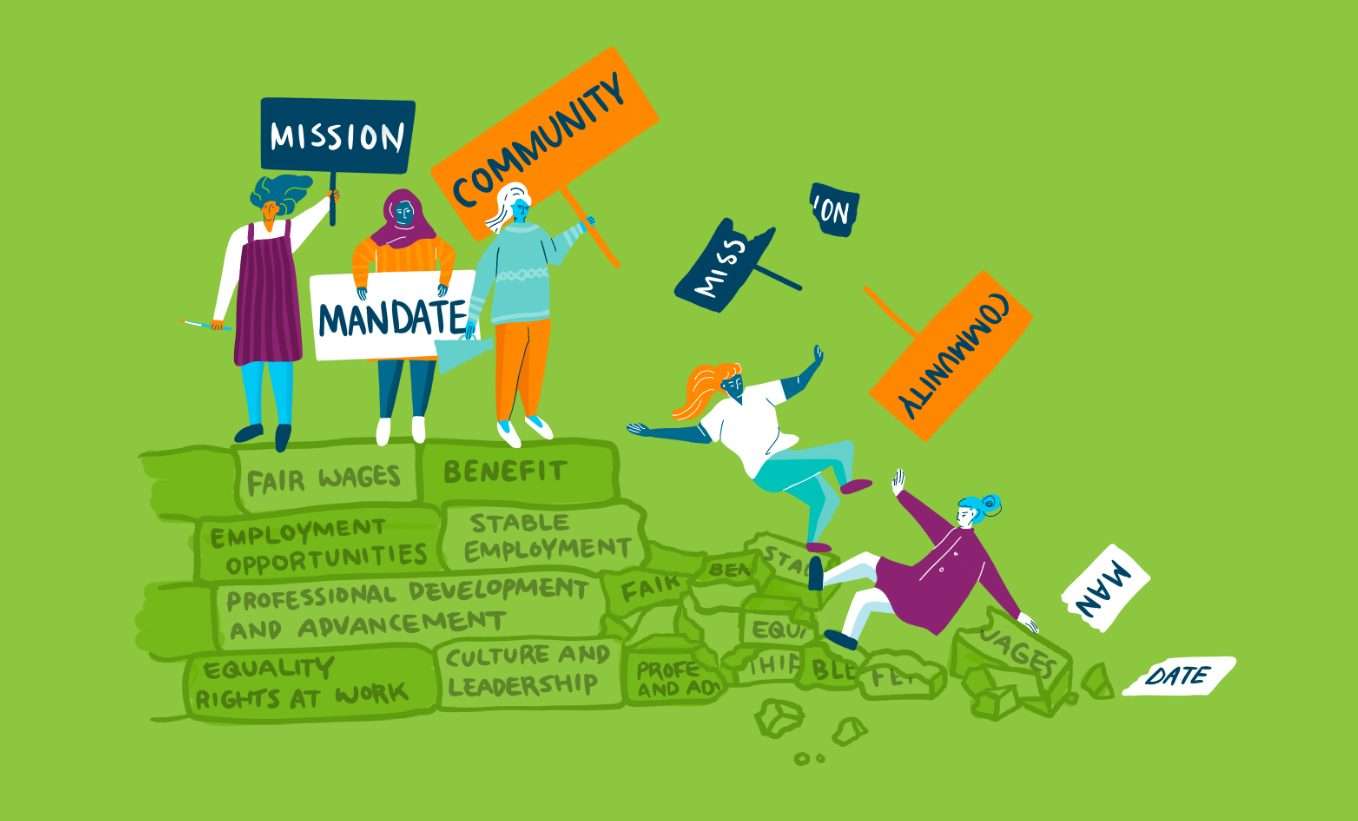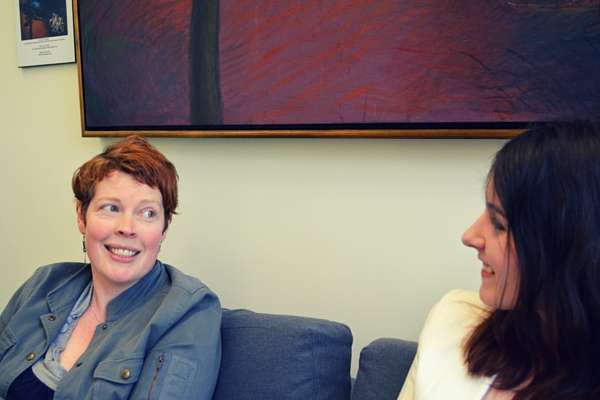
Blog
ONN in Conversation: Nonprofit workers deserve to retire with a pension plan – Archived Content
In our pensions work, there are a lot of terms and definitions, a lot of moving parts, and a lot of different ideas about what a sector-wide pension plan could look like.
That’s why, to make sense of our progress on a sector-wide pension plan, I (Tara, here!) sat down for a conversation with my colleague Liz Sutherland, ONN’s Policy Advisor, to chat about one of her most active files. The sector, with the help of our dedicated Pensions Task Force, is making waves to close pension gaps, help nonprofit employers attract and retain the leaders with skill sets needed now for the sector, and support the sector’s decent work movement. Now, on to the conversation. [line]
Want to read the answers that interest you most first? Not a linear reader? Click on the questions below to easily navigate the interview!
- Why do we need a sector-wide pension plan?
- Tell us about the task force. Why is this the best working model to develop the plan?
- What have you done with the task force to-date? What is on your short-term agenda?
- There’s also the ORPP that will affect sector pensions. What does the sector need to know about the ORPP?
- We can’t introduce a sector-wide pension plan without considering the ORPP. How will the two affect one another?
- What can the sector expect from the development of the sector-wide plan in the coming months?
- Describe the long term. What will our sector look like with a sector-wide pension plan?
- Next steps – what do you need from the sector in order to make a sector-wide plan happen?
Why do we need a sector-wide pension plan?
This project was an outgrowth of the decent work agenda. The elements of decent work – income adequacy and employment security and benefits – tie naturally into benefits and retirement security. A lot of people don’t have a workplace pension plan, and many don’t think about it. If you don’t have that, and you don’t have personal savings, you end up relying on the CPP, Old Age Security, and the Guaranteed Income Supplement, which combined will not give you enough retirement income to maintain your standard of living. You will end up far below what your working income provides.
Why don’t people think about it? A lot of people are under financial pressure – cost of living has gone up, childcare is expensive, post-secondary education is expensive – so they have to think about their more immediate needs. A lot of younger people don’t even think about retirement income because it seems so far down the road.
The nonprofit sector faces recruitment and retention challenges, such that, after a few years in the sector, too many people move to government or the private sector because they are attracted by the pensions they could have working elsewhere. A sector-wide pension plan has been proposed as a way of addressing those recruitment and retention challenges, so we can keep more of our great talent in the sector.
A sector-wide pension plan also spreads the risk so no one nonprofit takes all the risk. You can move from employer to employer and, as long as you’re working at a nonprofit that’s bought into the plan, you’re covered.
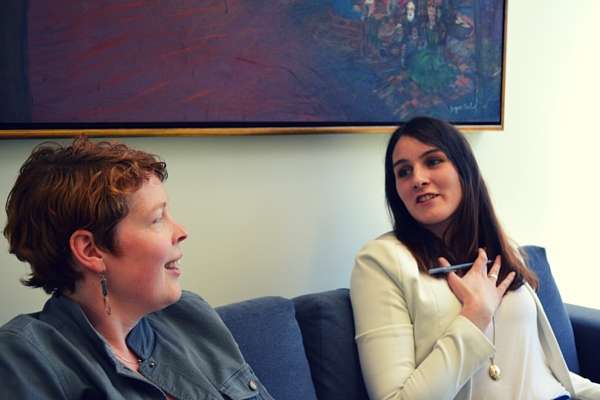
Liz Sutherland, ONN Policy Advisor and Tara Mazurk, ONN Engagement Coordinator chat nonprofit pensions plans
Tell us about the task force. Why is this the best working model to develop the plan?
Pensions are complicated things. There are a lot of moving parts (see the pensions glossary) and we wanted to make sure that we designed a plan that was a good fit for the sector with our particular needs. So we needed some people who had a strong pensions background, and we needed some people who had a strong nonprofit sector background. We have on our pension task force an executive director, a nonprofit worker, a statistician, a retired senior public servant, a retired lawyer who has negotiated multi-workplace pension plans, and we have people who have negotiated nonprofit pension plans at their former workplaces. A great mix of people, and they are going to come up with a plan that is tailor-made for the sector.
What have you done with the task force to-date? What is on your short-term agenda?
We’ve spent a lot of time trying to define the problem in a way that makes it solvable. We’ve looked at the landscape; there’s limited data available on the workforce in the nonprofit sector but we’ve looked at what’s available. We’ve looked at the landscape around public pension plans, so the possible CPP enhancement, the introduction of the Ontario Retirement Pension Plan (ORPP), and what we propose makes sense in the current political and policy landscape. We’ve essentially narrowed down our focus to a few key questions about the sector-wide plan design, addressing the needs of nonprofit workers to maintain their standard of living and affordability needs.
There’s also the ORPP that will affect sector pensions. What does the sector need to know about the ORPP?
The Ontario Retirement Pension Plan was introduced by the Ontario government because, at the time, there was no sign that there was going to be consensus about enhancing the CPP, even though many people acknowledged that it was supposed to happen and that it needed to happen. The CPP only replaces 25% of your income – the maximum you can get is about $12,000 a year and the average is about $6,000 a year. It’s not a lot to live on even when you combine it with other public plans. So the Ontario government introduced the ORPP. There was a preliminary piece of legislation two years ago and, just this spring, it’s passed Bill 186, an implementation bill that lays out what it looks like and how employers and employees are going to be affected. What’s going to happen is the new administration will contact every single employer to register them if they don’t have a comparable workplace plan. Unless you already have a comparable workplace pension plan (not a group RRSP), you will likely be starting to pay premiums once it rolls out. The roll-out timeline is, if you have 50+ employees, you will start paying premiums on January 1, 2018, and, if less than 50, January 1, 2019.
In the design of our plan, we’ve struggled with how our sector-wide pension plan would work with the ORPP— whether it should aim to be comparable to the ORPP so as to exempt participating workplaces from the ORPP, or instead simply supplement it. It’s one of our major discussion questions. What we’re leaning toward now is that the ORPP is going to be a large plan that will be able to deliver low administrative costs and good returns, and it’s going to be around for the long haul, so we don’t necessarily want to make nonprofits exempt from it. Our current thinking, not yet final, is a plan that builds on top of the ORPP and doesn’t replace it.
We’d like to have a plan that even contract employees are eligible to pay into. The advantage of a sector-wide plan is that it’s broad enough, if it covers enough workplaces, that you can go from contract to contract and still stay in the same plan as long as you move to employers that are in this plan. Nonprofits would have to voluntarily sign on and buy into it.
We can’t introduce a sector-wide pension plan without considering the ORPP. How will the two affect one another?
We would like our plan to be ready to go when the ORPP rolls out to smaller workplaces in 2019. At this point, pensions are on people’s minds so it’s a good time to raise awareness and get people to buy in. The other piece in harmonizing our roll out with the ORPP is that the ORPP ramps up over 3 years: the first year you pay in, the employee pays 0.8% and the employer pays 0.8%; the second year it’s 1.6%; and then, in the third year, it reaches the ongoing level of 1.9%. We’re trying to make our plan similar so that it doesn’t come as a big cost hit for nonprofits. It makes it easier for their budgets to absorb a gradual increase over time.
One model that we’re looking at is the sector-wide pension that was rolled out in Quebec. Nonprofits can join that plan for as little as 1% each (employer and employee). As far as we know, in Ontario, there’s not another plan where you can join for such a low contribution. Ideally, we’d like to design a plan where you can start with minimal contributions. We’re looking at other provinces, too. There are some plans that are sub-sector specific (for Manitoba daycare workers, for example), but there’s no other plans for the entire nonprofit sector besides what’s available in Quebec.
What we’re doing is creating a multi-employer pension plan. So if we develop one from scratch, rather than buy into one that already exists for the nonprofit sector, we’ll have to work with the Minister of Finance to make sure our plan is aligned with regulatory frameworks.
What can the sector expect from the development of the sector-wide plan in the coming months?
We’ll have recommendations for the plan for the ONN Conference on October 20, 2016. We’ll probably have a travelling roadshow where we’ll engage the sector and gauge the level of interest. We’ll have to have a deadline for whether it’s stop or go, and, if we’ve hit critical mass at that point, we’ll send out an RFP for the plan. It won’t be live in 2017, but I think it could be live in 2018.
Describe the long term. What will our sector look like with a sector-wide pension plan?
I think we could have a sector that doesn’t necessarily face the same recruitment and retention challenges that it does now. You may see people moving from one organization to another, but you might not see them moving to the private and public sectors in the same numbers that you see now. It’s been shown that pensions are key to retention in workplaces.
Right now you see people reaching the age of retirement without knowing what the heck they’re going to do – with our pension, people will be a lot more prepared. We’ve heard a lot of stories about people who are surprised when they realize that their organization isn’t going to provide anything for them when they retire and there’s no plan in place. There’s an assumption that your organization will look out for you or that the public programs will be enough. In almost every other OECD (Organisation for Economic Co-operation and Development) country, the equivalent of what you would make through CPP and Old Age Security would be enough to live on. Many industrialized economies have pension plans that are more generous than what we have here in Canada.
It may not be realistic to expect all young people to think about pensions, but the sector-wide pension plan would allow them to focus on what they need to, and they will be better off later. I would love to see pensions literacy go up. It will take a concerted effort for the sector to understand pensions. What we’ve learned from the Quebec nonprofit sector pension plan roll-out is that they went around to organizations and did presentations to show what the state of people’s retirement security would be. And they talked about the advantages of the plan and the alternatives that were out there. It takes a concerted effort to get the knowledge out there.

We want to make sure our sector workers don’t have to worry about retirement income security in future
Next steps – what do you need from the sector in order to make a sector-wide plan happen?
Pensions have been on the sector’s mind for quite some time. For decades. Everytime we go out to the sector, people say, “Yes, there’s a need. Enough talk, time for action.” So we’re taking a risk by developing this, but we hope there will be significant uptake if we design it well. Nonprofit employers and employers are thinking about the long term well-being of our workforce.
The task force has reached a point where we need broader input on what the plan should look like in order to make some key decisions. Aside from balancing retirement income levels with affordability for nonprofits, there a lot of key design features that we need the sector’s input on. In early June, we’ll send out a questionnaire and we’d love to have people respond and let us know what’s important to them. For example, some pension plans do or don’t consider years you’ve taken away from work for child rearing. Certainly these provisions would be available to anyone, but it recognizes that women are still more likely than men to take time off to look after children. We have 75-80% women in our sector, so it’s a big deal. We want to know if this is important to consider in the pension design for the nonprofit sector. Do we want a no frills pensions? What are the pros and cons of those different approaches. [line]
Get Involved!
Join our Pensions mailing list
Subscribe for Pensions Updates
Join the conversation! Pensions will be a focus at Nonprofit Driven 2016, ONN’s annual conference.
Register Now For Nonprofit Driven
Want a quick overview of our pensions policy work?
